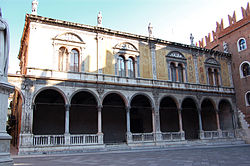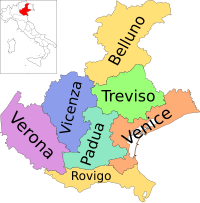Province of Verona
Province of Verona
Provincia di Verona (Italian) | |
|---|---|
 Loggia del Consiglio, the provincial seat | |
 Map highlighting the location of the province of Verona in Italy | |
| Coordinates: 45°26′N 10°59′E / 45.43°N 10.98°E | |
| Country | |
| Region | |
| Capital(s) | Verona |
| Comuni | 98 |
| Government | |
| • President | Manuel Scalzotto (League) |
| Area | |
• Total | 3,109 km2 (1,200 sq mi) |
| Population (31 December 2014) | |
• Total | 923,664 |
| • Density | 300/km2 (770/sq mi) |
| GDP | |
| • Total | €29.406 billion (2015) |
| • Per capita | €31,858 (2015) |
| Time zone | UTC+1 (CET) |
| • Summer (DST) | UTC+2 (CEST) |
| Postal code | 37010-37014, 37016-37024, 37026, 37028-37032, 37035-37036, 37039-37047, 37049-37060, 37063-37064, 37066-37069, 37121-37142 |
| Telephone prefix | 045, 0442 |
| ISO 3166 code | IT-VR |
| Vehicle registration | VR |
| ISTAT | 023 |
| Website | portale |
The province of Verona (Italian: provincia di Verona) is a province of the Veneto region in Italy. On its northwestern border, Lake Garda—Italy's largest—is divided between Verona and the provinces of Brescia (Lombardy region) and Trentino (Trentino-Alto Adige/Südtirol region). Its capital is the city of Verona. The city is a UNESCO World Heritage Site.[2]
The province is cosmopolitan in nature. It is bordered by Italian Tyrol in the north, province of Vicenza and province of Padua in the east. province of Rovigo and province of Mantua in south and Lake Garda in the west. From north to south the maximum extent of the province is 50 miles while it is 25 miles from east to west.[3]
Overview
[edit]The province has an area of 3,109 square kilometres (1,200 sq mi) and a total population of about 0.9 million. There are 98 comuni (sg.: comune) in the province. Important comuni include Bovolone, Bonavigo, Bussolengo, Cerea, Isola della Scala, Legnago, Negrar di Valpolicella, Peschiera del Garda, San Bonifacio, San Giovanni Lupatoto, San Martino Buon Albergo, Soave, Sona, Valeggio sul Mincio and Villafranca di Verona.[4]
William Shakespeare's play Romeo and Juliet takes place in Verona, as do some scenes in his play The Two Gentlemen of Verona. Verona attracts many tourists, and the Casa di Giulietta (Juliet Capulet's villa in the play) is an important local visitor attraction.[2]
Due to its historic importance, the province boasts a large number of castles, towers, hermitages, monasteries, sanctuaries, and old Romanesque parishes. A regional park is located in Lessinia. Valpolicella is popular for its wines which are made from indigenous techniques. Europe's biggest natural bridge-Ponte di Veja is located in the province. The northern part of the province is mostly hilly, with several rivers, including Tartaro, Caslagnaro and Adige.[3]
References
[edit]- ^ Regions and Cities > Regional Statistics > Regional Economy > Regional Gross Domestic Product (Small regions TL3), OECD.Stats. Accessed on 16 November 2018.
- ^ a b "Verona, Veneto". Italia. Archived from the original on 9 October 2014. Retrieved 18 September 2014.
- ^ a b The Penny Cyclopaedia of the Society for the Diffusion of Useful Knowledge. 1843. p. 268.
- ^ "Banca Dati Provincia Verona" (in Italian). Unione delle Province d‘Italia. Archived from the original on 28 April 2014. Retrieved 18 September 2014.
External links
[edit] Media related to Province of Verona at Wikimedia Commons
Media related to Province of Verona at Wikimedia Commons- Tourist information



